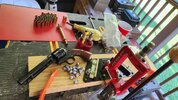Dave Markowitz
Member
I've loaded black powder in .38-40, .44-40, and .32 S&W (not Long). I've only tried 3Fg, but I've used Goex, Old Eynseford, Scheutzen, and Swiss. Swiss left the least fouling in .44-40 for me.
I generally use Starline brass in .38-40 and .44-40.
For both .38-40 and .44-40 a full load is 2.2cc of 3Fg, under 180 grain and 219 grain bullets, respectively. 2.2cc in a Lee dipper is about 35 grains of powder. This is slightly compressed. I do not use a separate powder compression die, just seat the bullet.
Another load in .44-40 I've tried is a reduced load to approximate .44 Henry Flat ballistics, mostly for use in my Cimarron 1860 Henry rifle. That load is 28 grains / 1.8cc of 3Fg, topped by either 0.5cc or cornmeal or a 1/8" thick card wad, and the same bullet I use with full loads. Again, it's a compressed load. This Henry-equivalent load is more tedious to assemble, but fouls noticeably less. It's also a lot more pleasant to shoot in revolvers compared with full-house BP loads.
My .32 S&W BP rounds were loaded for my 1878-vintage S&W No.1-1/2 Single Action. I decapped and resized the once-fired Remington brass on my press, but I used an antique Ideal tong tool to load the rounds, using 78 grain bullets cast in its integral mold. They were loaded with 0.3cc / ~5 grains of 3Fg Old Eynesford, all I could fit in modern cases. I'd probably be able to get 0.5cc / ~9 grains in balloon head brass, which would duplicate the original load.
I generally use Starline brass in .38-40 and .44-40.
For both .38-40 and .44-40 a full load is 2.2cc of 3Fg, under 180 grain and 219 grain bullets, respectively. 2.2cc in a Lee dipper is about 35 grains of powder. This is slightly compressed. I do not use a separate powder compression die, just seat the bullet.
Another load in .44-40 I've tried is a reduced load to approximate .44 Henry Flat ballistics, mostly for use in my Cimarron 1860 Henry rifle. That load is 28 grains / 1.8cc of 3Fg, topped by either 0.5cc or cornmeal or a 1/8" thick card wad, and the same bullet I use with full loads. Again, it's a compressed load. This Henry-equivalent load is more tedious to assemble, but fouls noticeably less. It's also a lot more pleasant to shoot in revolvers compared with full-house BP loads.
My .32 S&W BP rounds were loaded for my 1878-vintage S&W No.1-1/2 Single Action. I decapped and resized the once-fired Remington brass on my press, but I used an antique Ideal tong tool to load the rounds, using 78 grain bullets cast in its integral mold. They were loaded with 0.3cc / ~5 grains of 3Fg Old Eynesford, all I could fit in modern cases. I'd probably be able to get 0.5cc / ~9 grains in balloon head brass, which would duplicate the original load.















